Spending a weekend exploring Intramuros is an appealing idea for those who love to discover Philippine history and culture. Aside from museums and historic sites, there are art galleries, shops and restaurants. The area outside the Walled City also offers leisure activites like jogging, golf, and a kick-ass aquarium. Prepare for a memorable weekend for the inquisitive mind.
DAY 1
1pm. Keep yourself in a Spanish colonial frame of mind (with modern amenities to boot) by checking in at the reasonably priced (PHP2000-PHP4000 per night) White Knight Hotel, located inside the Barrio San Luis Complex on General Luna Street.
2pm. Now that you’ve dumped your luggage in your hotel room, squeeze into comfortable clothes and start exploring Fort Santiago which is some 10 minutes away from your hotel.
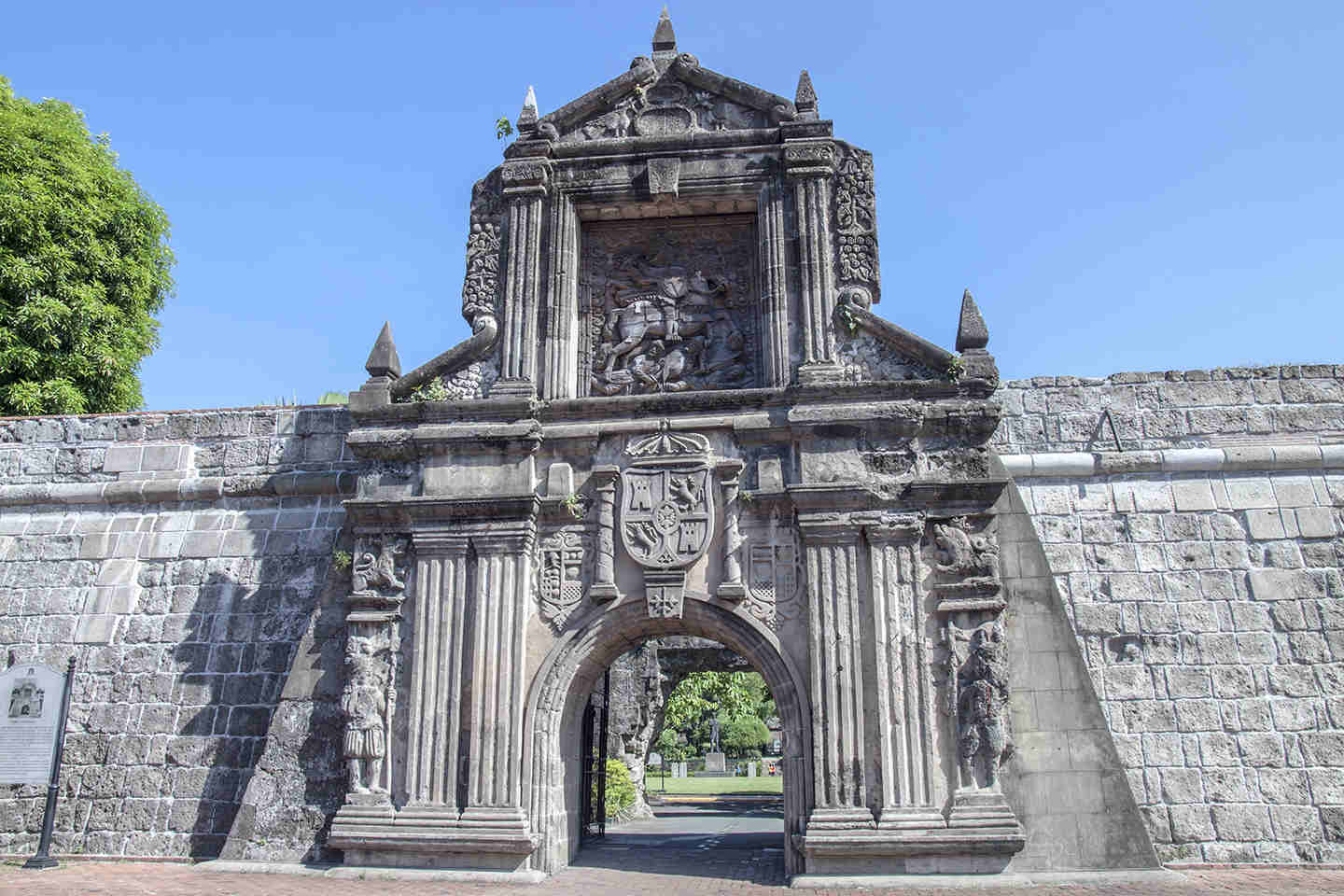
Entrance to Fort Santiago, seat of Rajah Sulaiman’s kingdom before the arrival of the Spanish conquistadores.
This is where the kingdom of Rajah Soliman was located before the Spanish conquistadores arrived. When the colonizers took over the space, Sulaiman and his people were forced to move one kilometer away to a new place called Bagumbayan (more on that later). The Spaniards then turned Rajah Soliman’s “palace” into a military headquarters and named it after San Santiago — Saint James, who converted Spain to Catholicism — thus it the name Fort Sanitago.
The fort remained a military base up until World War II, when it was heavily bombed during the Battle of Manila. Except for one barrack, most of the ruins have been kept as is. The lone restored barrack is where our national hero, Dr Jose Rizal, was kept before being executed by a firing squad in 1896. Now known as the Rizal Shrine, it was recently renovated so visitors can get a better sense of Dr. Rizal’s life and influence. Among the more interesting items on exhibit is a piece of his spine that has a mark as to where the bullet passed when he was executed.
After visiting the Rizal Shrine, ride a calesa. If you are not interested in hiring them as a guide, you can ride around the gardens of Intramuros for only PHP50 per person. You can choose from a variety of carriages: from the elegant carruaje (open air carriage) to one that looks fit for a Cinderella or something that resembles an Amish wagon.
3pm. Exit Fort Santiago, turn left down the street, then turn around the corner to General Luna Street and head to Plaza Roma. The plaza has been called different names at different times of our history. It was only after a Filipino was appointed cardinal in the 1960s that it acquired its current name. As an exchange deal, there is a Piazzale Manila, complete with a bust of Dr. Jose Rizal, somewhere in Rome’s Flaminio district.
In the middle of Plaza Roma is a statue of King Carlos IV. This is to honor his act of sending to Manila smallpox vaccine — with a little help from Mexican orphans. The orphans served as live host for the vaccine during the long voyage across the Pacific.

The San Agustin museum is adjacent to the church and home to a collection of Spanish-era goodies.
In the 1970s, the GomBurZa statue replaced King Carlos IV. Gomez, Burgos and Zamora were priests who attempted to reform the local Catholic Church during the Spanish colonial period. GomBurZa’s activity was met with disapproval from the church authority — no surprise there — and they were publicly executed.
It was their deaths that inspired Jose Rizal to write his novels urging reforms during the Spanish colonial rule. After the GomBurZa statue was moved in front of the National Museum in the 1980s, King Carlos IV took back his place in the center of Plaza Roma.
On one side of the plaza is where you will find the Palacio de Gobenador. This is where the original Governor General Palace stood before it was demolished in the quake of 1863, prompting the official residence’s move to Malacañan by the Pasig River.
The original palace was built in the 1650s under the administration of Governor General Diego Fajardo. It was built by one of his aides, Manuel Venegas, but became government property when it was discovered that Seňor Venegas was extorting from the Chinese and Spanish merchants to fund his building activity. After his arrest and execution it was turned over to the authority as the official residence of the Governor General.
On the other side of the plaza is where you will find the Ayuntamiento, formerly Manila’s City Hall.
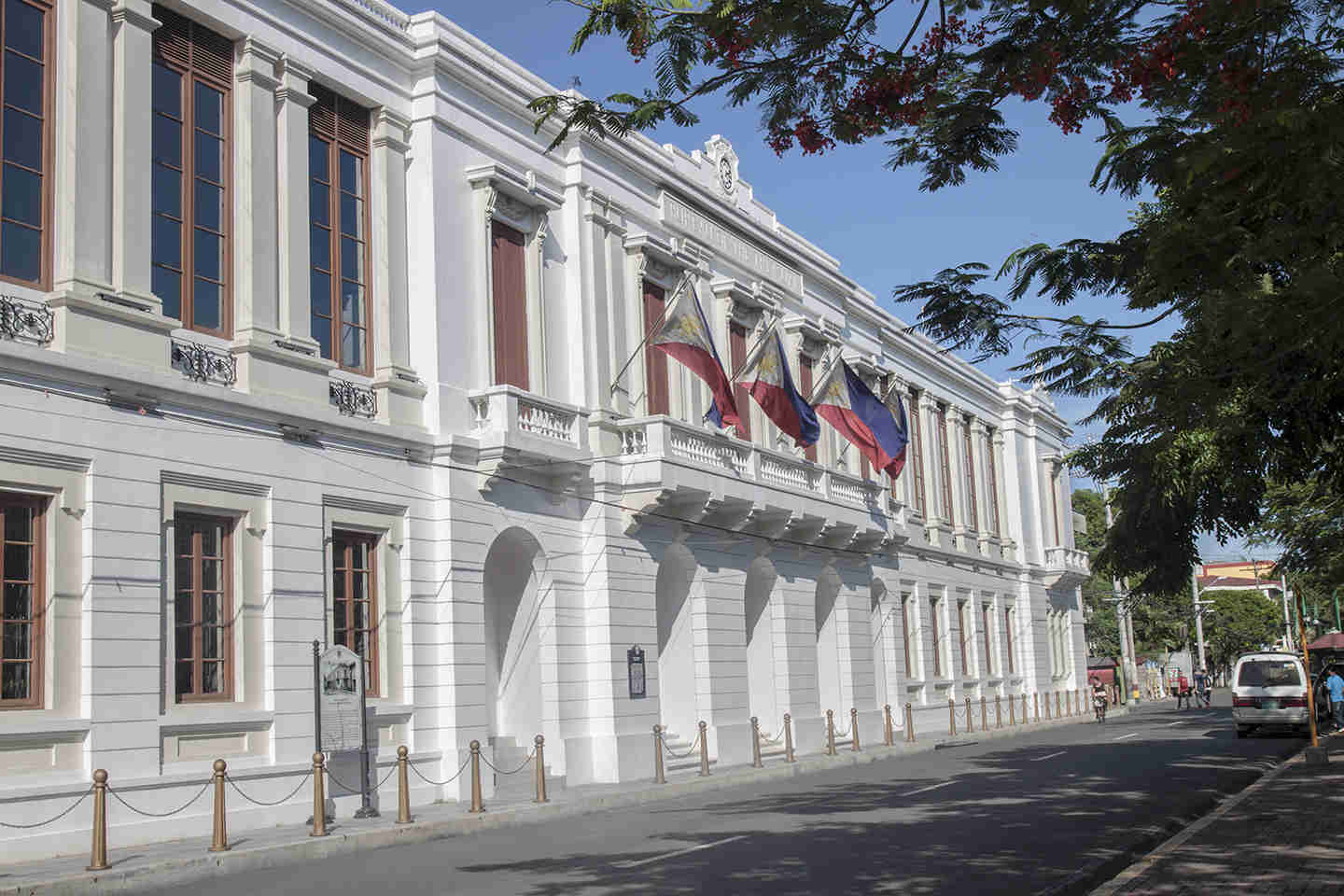
The restored Ayuntamiento was the original City Hall until it was bombed in World War II. It is now the Bureau of Treasury.
Bombed in World War II, it has since been reconstructed and now serves as home of the Bureau of Treasury. As of now it is not open to the public, and it is said that the builder tried to be as authentic as possible in recreating the original interiors.
But the structure that looms over Plaza Roma is Manila Cathedral. This is the eight incarnation of the cathedral since it was first constructed in 1581 out of bamboo, wood and nipa.
The current cathedral was built in 1953 to replace the one that was destroyed during World War II. Despite standing firm in the face of earthquakes and typhoon, it was found out two years ago that the cathedral was sinking. So the cathedral was closed down for repair and improvement works. It reopened this year to glowing reviews.
3:30pm. A block behind the Cathedral from Cabildo Street is one of the best places to shop in Intramuros, The Manila Collectible Co. Not only can you buy traditional handwoven textiles and tribal jewelry hee, it also has Lagu’s beach-friendly blanket and local hip-hop baseball caps by WIP. If you have kids with you, you can book a tour with co-owner Charisse Tugade, as she specialize in tours for children. They also have an exhibit space as well as an activity center for children. Occasionally they would have live demonstration as to how local handicrafts are made. You can also visit the rooftop and enjoy a view of Manila Cathedral from behind.
4pm. Go back down Cabildo Street and find Bahay Tsinoy. This museum highlights the contribution of the Chinese to local history and culture through the use of life-size dioramas, artifacts, photos and a hologram presentation.
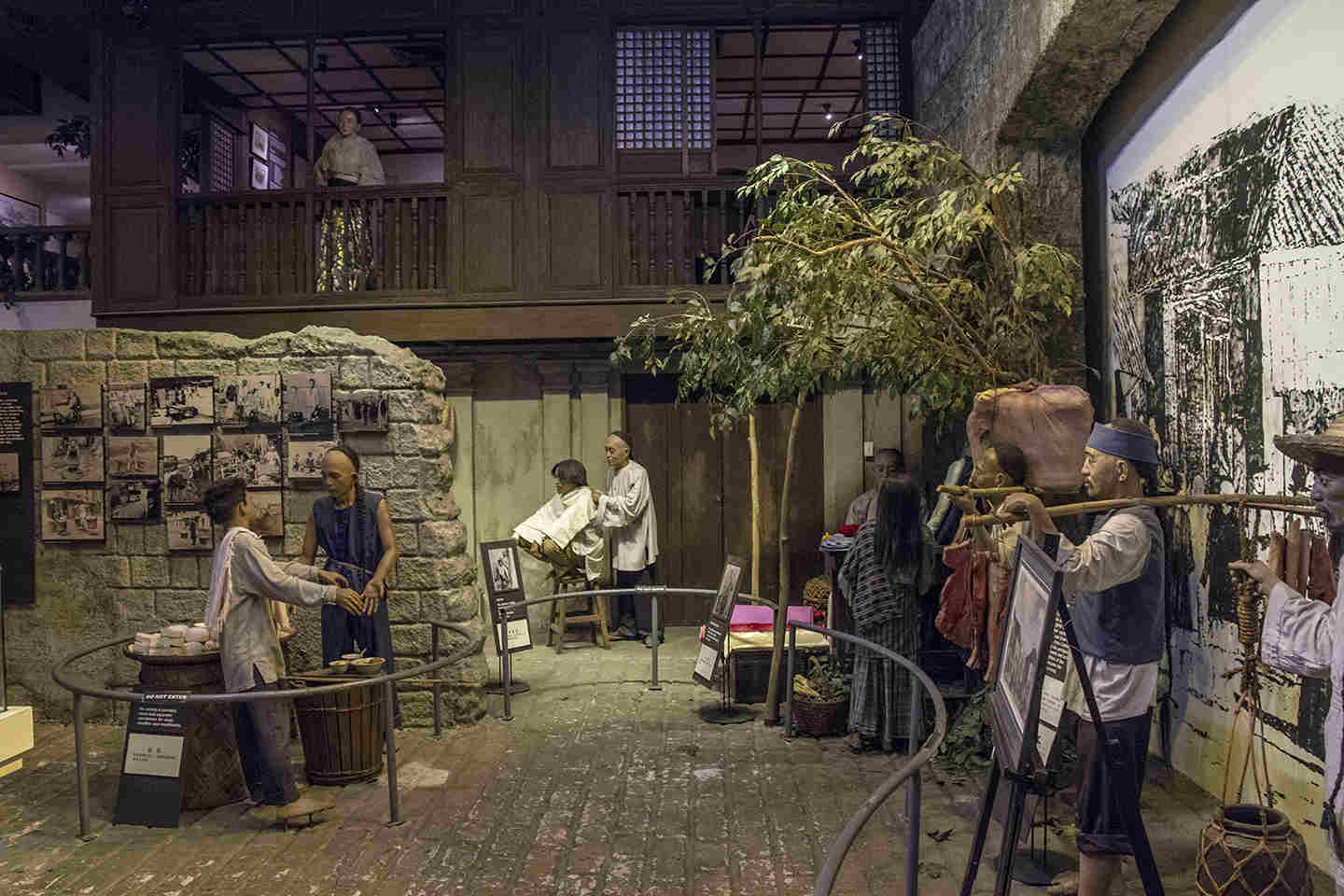
Bahay Tsinoy chronicles the history of the Chinese Filipino community in the Philippines with dioramas, photos and a light and sound show.
Upon exiting the museum, turn right on Anda Street and back to General Luna Street where you will find a small plaza with a monument called Memorare Manila 1945. It was set up to commemorate the more than 100,000 civilian casualties who died during the Battle of Manila.
From General Luna, turn left at Beaterio Street. Just next to the Cathedral is the Knights of Columbus building. This Catholic men’s club is open to the public. You can come in for a game of bowling (PHP25 per game) or play billiards (PHP75 per hour). The old-fashioned bowling alley is interesting as they still use a staff member as a pin setter.
5:30pm. Head to the Bayleaf Hotel on Muralla Street, beside Lyceum of the Philippines University. Proceed to 10th floor in time for sunset from the Sky Deck View Bar. You can then enjoy a lovely view of the Manila Bay sunset and Manila’s skyline — as long as it is not raining. You can stay on for dinner or, if the weather is not cooperating, go down a floor below to the 9Spoons restaurant and hit the buffet line.
DAY 2
8am. To burn off the calories after breakfast we suggest that you walk down Real Street down to Puerto de Santa Lucia and Baluarte de San Diego. It’s the site of a fort that was integrated into the walls of Intramuros and a tower was added. It was later used as a cistern. Just around the corner from the baluarte, keep your eyes open for a small gate, take a look inside and you will see a Japanese artillery gun left over from World War II.
If golf is more your thing, head down Bonifacio Drive side of Intramuros and go to Intramuros Golf Club for a round of 18 hole par 66 course. The oldest golf court in Manila may be compact-size, but many golfers attest it can be tricky especially in sections where where you have to step off the grass to cross over a busy street to the other side of the golf course. If the lights are working, you can also do night golf in this course. It is open to non-members at PHP1000 per person for a round of go
9am. Walk to the San Agustin Church, built in 1604 and is the oldest continuously standing structure in Manila. It also the city’s lone UNESCO world heritage site.

San Agustin Church is the oldest continuously standing structure in Manila and the city’s lone UNESCO world heritage site.
It is an active parish where people actually come to attend Mass, get married or have their children christened. While there are so much stuff to discover here, but there six things that you should not miss: the breathtaking tromp l’oeil ceiling inside the church; the grand granite staircase and the brick dome; the carved wooden choir loft and organ; the church’s ivory collection at the Antigua Sacristia; the ossuary where there is a memorial to those who were killed by the Japanese soldiers inside the church during the Battle of Manila; and the Sala de Capitolacion where Spanish and American officials met to discuss the transfer of power after Spain lost to American in the Battle of Manila Bay.
10am. Cross the street to a row of houses that lead to the Barrio San Luis Complex where your hotel is located. Despite its appearance, this complex was only built in 1980 by the Intramuros Administration to give visitors a glimpse of what life was like during the Spanish period. The center of attraction is Casa Manila, a replica with authentic period furnishings.
11am. Aside from the hotel and museum, you will find a couple of shops within the complex. Bambike specializes in bespoke bamboo bikes. It also organizes tours and rents out bikes. You can also buy bamboo frame sunglasses as well as body bags made from recycled bike tires. You can also get refereshments here.
11:30am. Try the lunch buffet at Barbara’s (inside the San Luis Complex) for PHP495+ per person. Or walk down to Real Street and look for Ristorante delle Mitre inside the Catholic Bishop Conference of the Philippines building. This Catholic-theme restaurant extends to the menu where they feature favorites of the various cardinals and bishops across the country. Definitely have Manila Cardinal Luis Antonio Tagle’s silvanas for dessert!
Two other options, Illustrado and Cuatro Cantos, can be found further down the road at the Silahis Arts and Artifacts compound. For something unusual, try Cuatro Cantos’s take on local ice cream flavors such as boiled peanuts or sampaguita (a specie of jasmine which is the national flower).
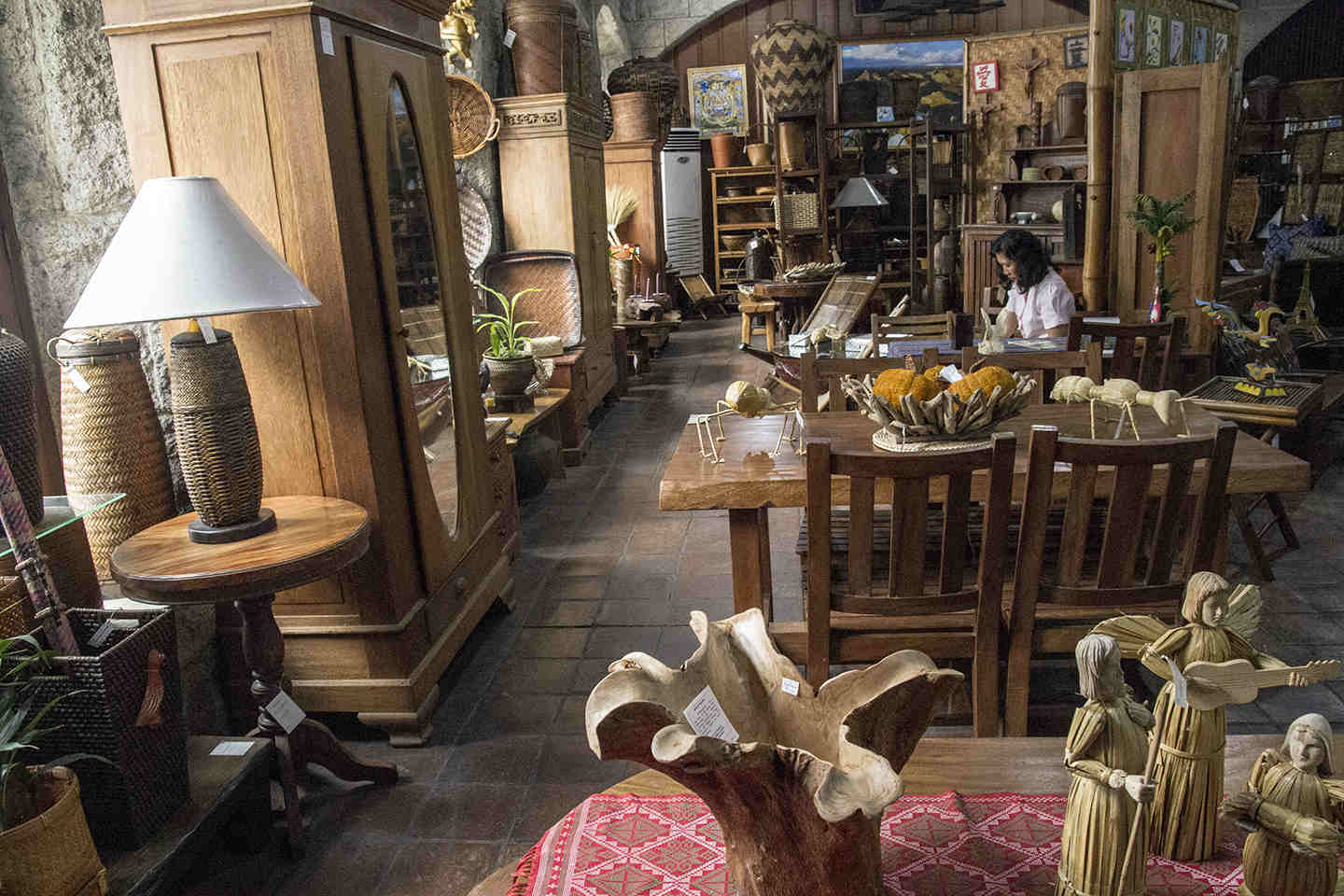
Silahis Arts and Artifacts offers three floors of Philippine collectibles sourced nationwide.
1pm. If you are dining at Cuatro Cantos, stay on after lunch and browse around the Silahis Arts and Artifacts. They have three floors of souvenirs, furniture, handicrafts, painting and books. Otherwise go back up Gen Luna Street where you might want to check out the National Commission for Culture and the Arts headquarters. The ground floor exhibit hall showcases the best in Philippines arts and culture. It can be anything from ethnic craft to local cinema to a tribute to a local artists.
2pm. Going back out to General Luna Street, turn right at Pamantasan Lunsod ng Maynila (or Fundacion Street) then turn right down Sta Lucia Street. Past the Baluarte de San Diego is the Intramuros Light and Sound Museum. Housed in a replica of the nunnery that stood here before, its main attraction is that it allows visitors to walk through life0size dioramas of key events in local history. At the back of the part of the walls of Intramuros is the Baluartillo de San Jose, a small arrow-shaped fort where General Douglas MacArthur had his office which he called “No.1 Victoria St.”
3pm. Make your way back to General Luna Street and to the gate where the cars pass through. Exit the gate and look for Puerto Real or the Royal Gate. As the name implies, this was the gate from which the ceremonial carriage used by either the governor general or the archbishop passed through. A smaller fortress or a revellin was later built to protect the main gate. During the American period they made this in to a public aquarium till it was destroyed in the Battle of Manila. Sometimes in the 1960s a medieval-theme restaurant called Round Table opened here. The restaurant has long since gone but the name stuck particularly with commuters. There was attempt in the late 1990s to revive the public aquarium, but it too eventually closed down.
 Intramuros at sunset — don’t forget to have a sundowner during your staycation.
Intramuros at sunset — don’t forget to have a sundowner during your staycation.
3:30 pm. By now you are leaving the Walled City. Walk across Padre Burgos Drive and turn right into Maria Orosa Street. Within a few steps you are now in the middle of Rizal Park. This was the site of Bagumbayan where Rajah Soliman and his people resettled after the Spaniards came. After the British Invasion of 1762, the area was cleared and made into a buffer zone in case of another attack.
Because of the crescent-shape fortresses nearby in Intramuros, this area came to be known as Lunette or Luneta. By the 19th century, aside from being used as a promenade ground, Luneta was the site of public executions. This was where the Gomburza and Dr. Jose Rizal were slain. When the Americans came, the city planner, Daniel Burnham, chose Luneta as the site for a civic mall. Except for a few buildings the civic mall never materialize. In its place, the open space gradually evolved into a 130-acre public park dedicated to Dr. Jose Rizal,

Sculptures by Isabelo Tampinco are a reminder of genteel Manila.
Like in the Walled City you can hire guides to show you around. The Mabuhay Restop, a restaurant and performance venue, offers three-hour tours that should give you the lowdown on all that Rizal Park has to offer. It is conducted at 4pm every day and includes a dinner buffet.
But if you want to explore on your own, walk down to the Roxas Boulevard side of the park where Rizal Monument is located. This monument/mausoleum is probably the closest Manila has to an iconic landmark. It was the result of a worldwide design contest launched in 1905. But the grand prize winner could not afford to put up his design, so the privilege instead went to the second place winner.
After it was unveiled in 1913, there were complaints that this monument was short for someone of Rizal’s stature. This is why during the 100th birth centenary of Dr. Rizal in 1961, a 17.8-meter stainless steel pylon was added on top of it. But the result wasn’t pleasing so it was removed immediately after the event.
Because this is where Dr. Rizal bones are interned, the Philippine Marine Corps has guards watching over the monument day and night. But what many people fail to realize is this was not where Dr. Rizal was executed. That is actually 100 meters to the west. This was corrected in the 1990s when a life-size light and sound diorama was set up on the execution site to show how Rizal bravely faced his final moments. The half-hour light and sound show starts at 7pm in Filipino and 8pm in English.
Other delights that this park offers include landscaped gardens by the late National Artist Ildefonso Santos, a planetarium, playgrounds and a giant relief map of the Philippines. Near Rizal Monument is there is the Kanlungan ng Sining, a place where artists create and exhibit their works.
While entrance to some of these attractions do require an admission fee, you can still find lot of freebies elsewhere. There is an open-air auditorium where concerts, film showing, ballet, dramas and ethnic dances are stage for free. There is also a lagoon with a dancing water fountain and it can shoot a stream of water 88 feet into the sky. Shows start at 8am and 6pm nightly
If you are feeling hungry, you can find plenty of snack kiosks around the area. For sitdown dining, there is The Hub near the Rizal Monument, managed by shipping line 2Go. Across Roxas Boulevard, there is Mabuhay Restop which serves affordable food and drinks.

The Rizal Monument is manned by Philippine Marine Corps day and night as this is where the national hero’s remains are kept.
4:30pm. Across from Rizal Monument is the Kilometer 0 marker where all road distances to the rest of the country are measured from. Over the horizon you will spot the roof of Quirino Grandstand. This historic structure has witnessed presidential inaugurations, papal mass, political rallies and military parades.
At the back of the grandstand is Manila Ocean Park, a marine theme park with a number of attractions that allows guests to interact with marine and avian creatures. You can swim with a school of fish, feed a penguin or even learn how to be a mermaid. Tip: Book way in advance.
6pm. It’s time for a sundowner. You can grab a cold bottle of beer at White Moon, an al fresco bar at Manila Ocean Park. If it is raining, run for cover to Makan Makan on the floor above and tuck into a pan-Asian dinner. Another option is the historic Manila Hotel across the street where you can enjoy the buffet at Café Ilang Ilang or have a formal dinner at the Champagne Room. Then stay around till 2am over drinks and live music at the Tap Room.

At Manila Ocean Park you can swim like a mermaid, no joke.
DAY 3
10am. By now your mind is swimming with all that you’ve seen the past two days, so process all that information white getting your muscles kneaded at Zenyu Spa inside Hotel H20 or the Manila Hotel Spa, located by the Manila Bay. Or you can continue with your cultural tour and check out National Museum — entrance is free on Sundays. Before that, make sure you have brunch to last you for a few hours into merienda.
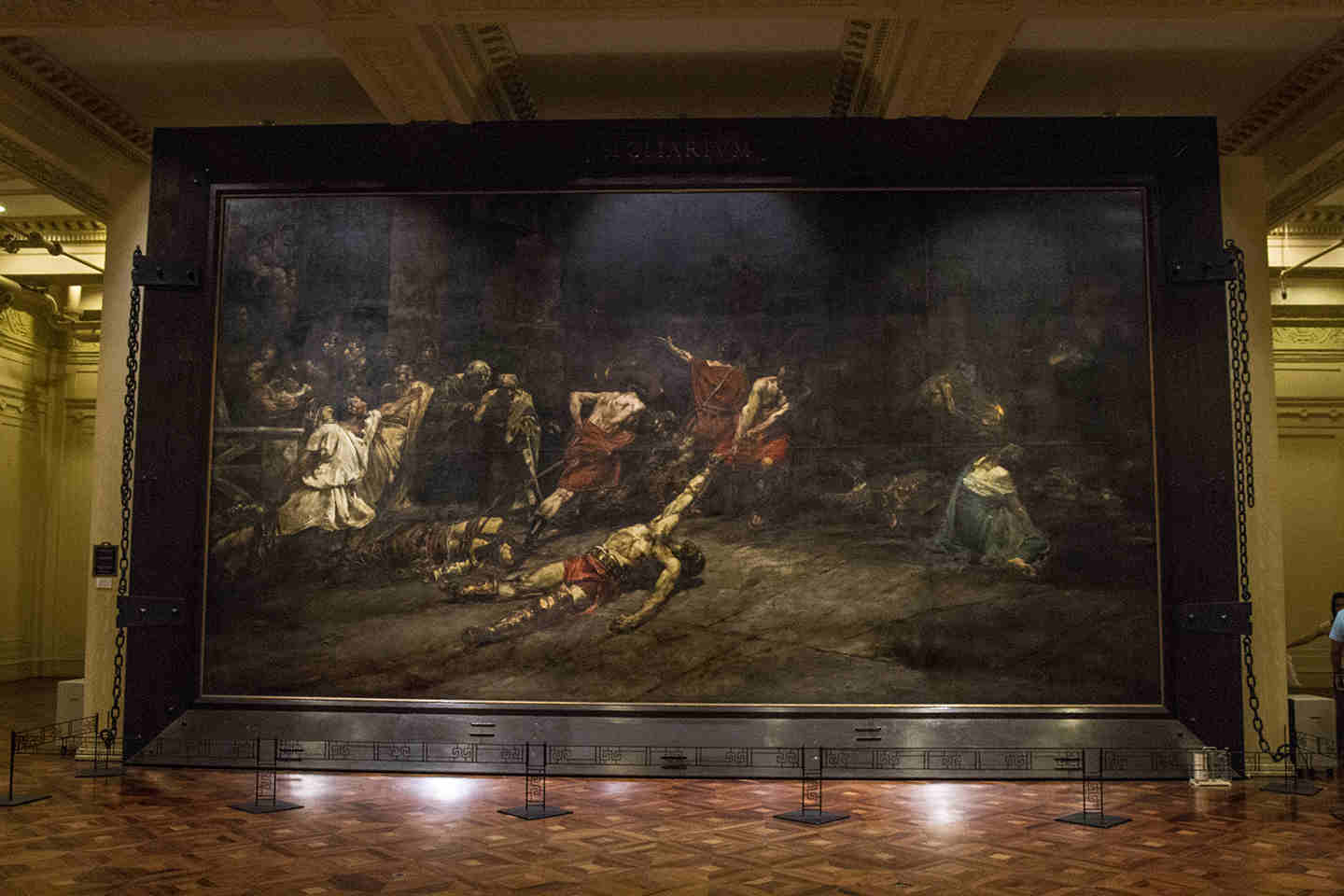
Juan Luna’s ‘Spoliarium’ depictind dying gladiators s a piece of art that you need to see at least once in your life.
The National Museum currently occupies two heritage structures built during the American period. What used to be the Finance building now housed the museum’s anthropological and archeological collection, while the former Senate building is home to the museum’s art collection. The two buildings are attraction in themselves as they have amazing architectural details. Noteworthy is the restored Senate Hall at the former Senate building and the marble hall at the Finance building. The complex is set to expand further with the former Department of Tourism building now transforming itself as the third component of the complex. When open, the exhibit will focus on local plants and wildlife. Must-sees include what was recovered from the sunken galleon, San Diego and Juan Luna’s Spolarium.
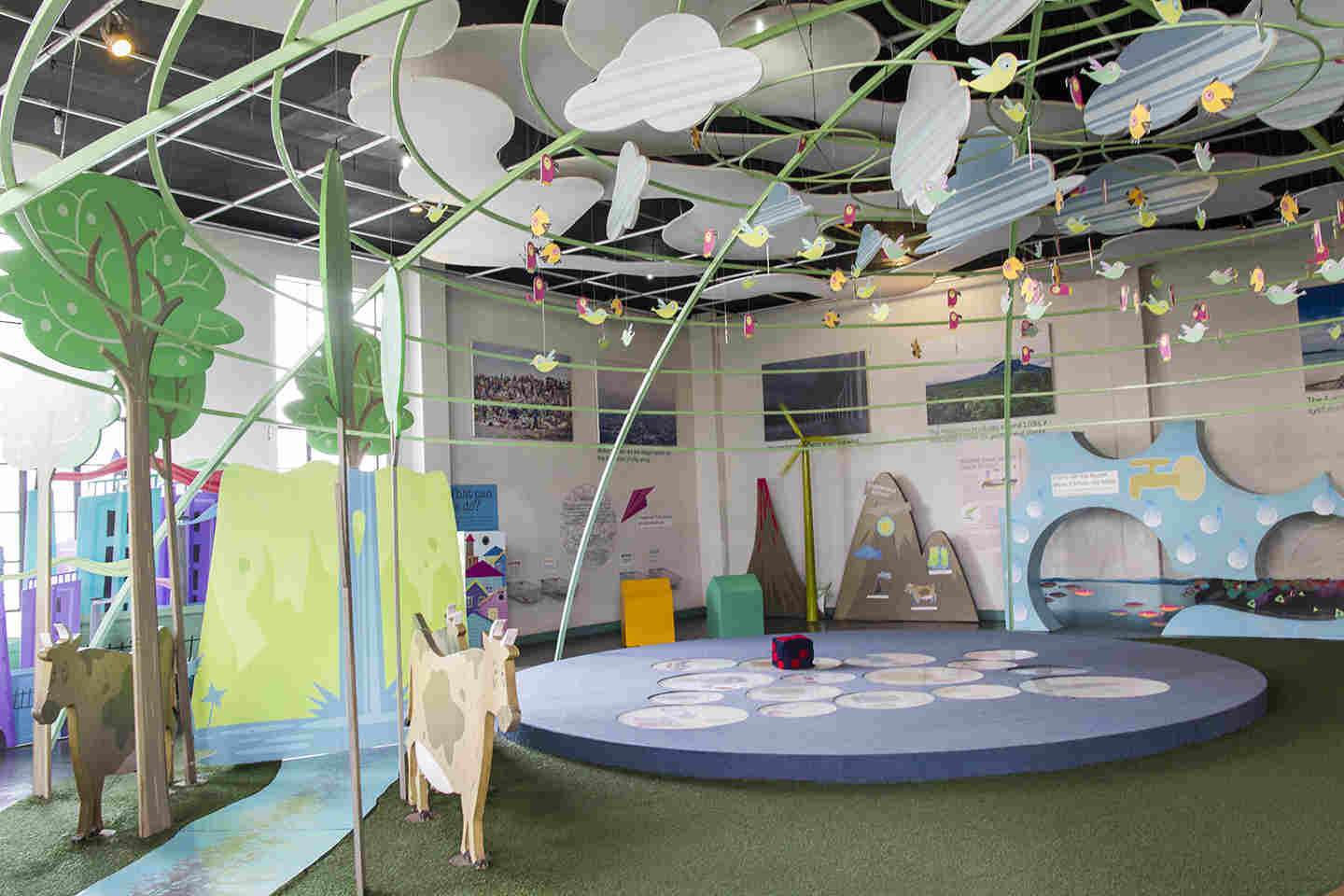
You don’t need to be a child to appreciate or learn new things from the Museo Pambata.
1pm. After you’ve checked out of your hotel, try and drop by the Museo Pambata along Roxas Boulevard. Open at 1pm on Sunday it is housed in what was once the Elk Club, an elite men’s club during the American colonial period. Under a deal made with Manila City Hall in 1994 it was transformed into a children’s museum. Even if you are a grownup you can still learn a lot from the interactive exhibits from how our eco system works to how our bodies work. A great place for the inquisitive mind.
Photos: Anson Yu
MORE STAYCATION STORIES:
– Friday, Satuday and Sunday in BF Homes Parañaque
– Friday, Saturday and Sunday in San Juan
– Friday Saturday and Sunday in Manila’s Chinatown
– Friday, Saturday and Sunday in Divisoria and Tondo
– Friday, Saturday and Sunday in Marikina City
– Friday, Satuday and Sunday in Quiapo and San Miguel
– Friday, Satuday and Sunday in Makati
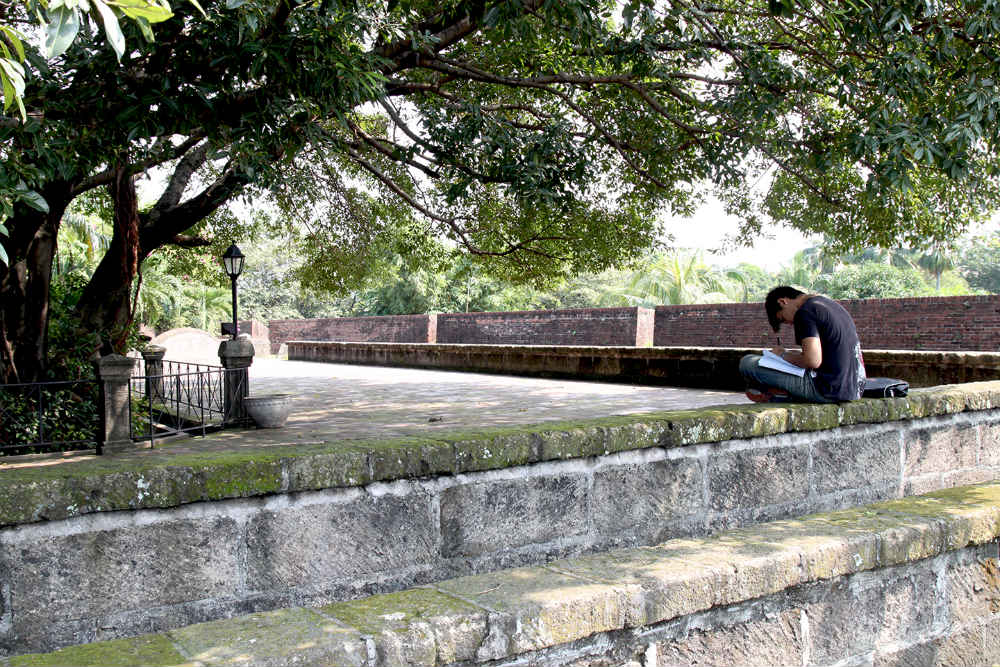

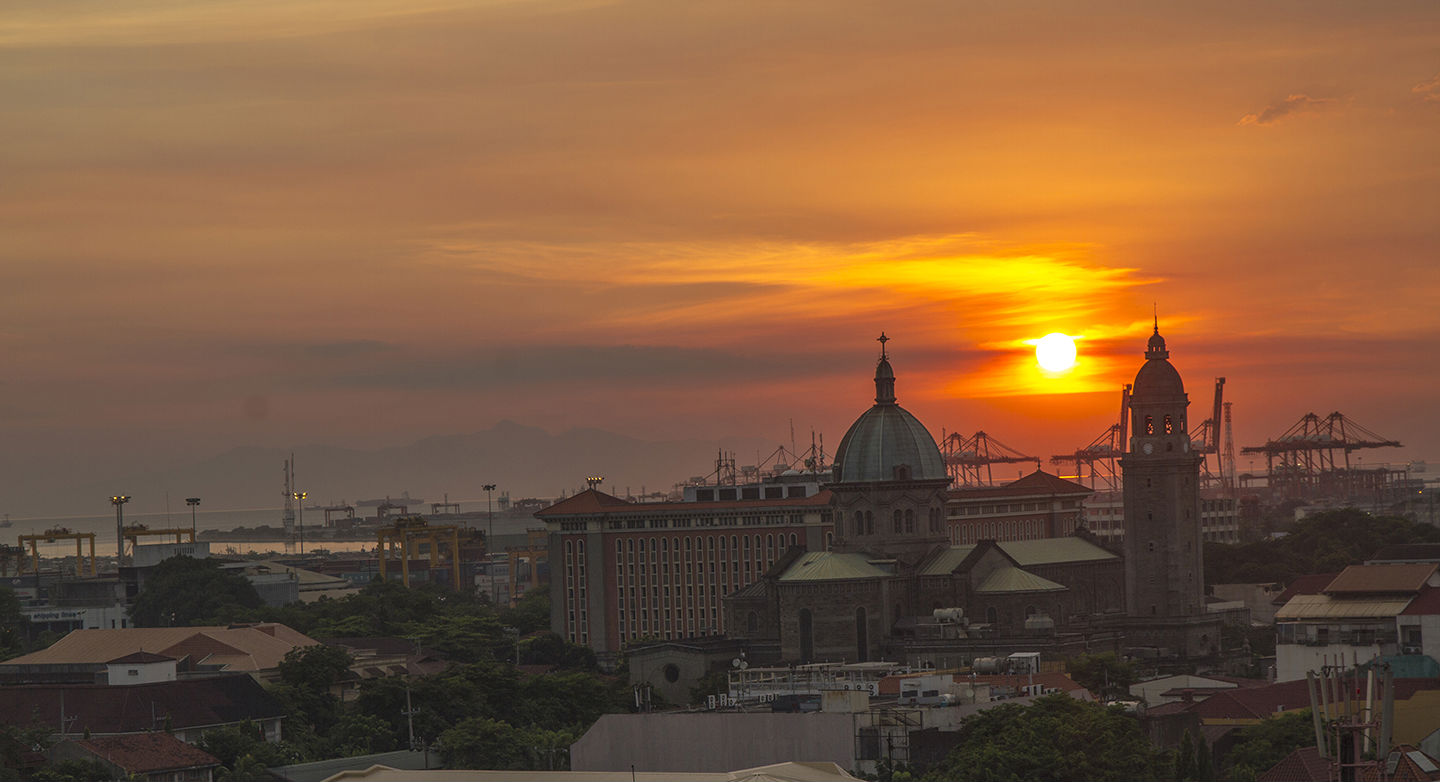 Intramuros at sunset — don’t forget to have a sundowner during your staycation.
Intramuros at sunset — don’t forget to have a sundowner during your staycation.


Reader Interactions